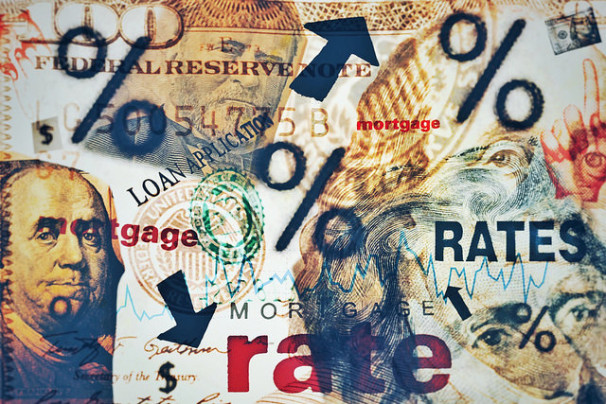According to the Mortgage Bankers Association’s Weekly Applications Survey, average mortgage rates were mostly down last week, in advance of the Fed’s latest policy announcement. Rates on 30-year fixed-rate mortgages with conforming balances were unchanged from the previous week while jumbo loans saw a slight decrease, as did loans backed by the Federal Housing Administration and 15-year fixed-rate loans. Because the Fed’s announcement may mean mortgage rates will be moving higher, refinance activity picked up from the week before. Michael Fratantoni, MBA’s chief economist, told CNBC borrowers were likely looking to move before rates do. “Some borrowers may have moved to lock in current rates in advance of the Fed’s likely increase this week,” Fratantoni said. Overall, demand for mortgage loan applications was down 1.1 percent from the week before, largely due to a 3 percent drop in the number of prospective buyers requesting applications. Still, purchase application demand remains 34 percent higher than at the same time one year ago. The MBA’s weekly survey has been conducted since 1990 and covers 75 percent of all retail residential mortgage applications. More here.
Archive for December 2015
Builders End Year On An Optimistic Note
Though down slightly from the month before, the National Association of Home Builders Housing Market Index remained at a high level in December. The Index – which measures builders’ perception of the market for newly built single-family homes – is scored on a scale where any number above 50 indicates more builders view conditions as good than poor. In December, the Index dropped one point to 61. David Crowe, NAHB’s chief economist, said the results are an indication that the residential real estate market will continue to make progress in the year ahead. “For the past seven months, builder confidence levels have averaged in the low 60s, which is in line with a gradual, consistent recovery,” Crowe said. “With job creation, economic growth, and growing household formations, we anticipate the housing market to continue to pick up traction as we head into 2016.” Each of the three individual index components suffered minor losses, including a two point decline in both the gauge of expectations for the next six months and buyer traffic. The component measuring current sales conditions fell just one point. The NAHB has been conducting the monthly survey for the past 30 years. More here.
How Long Should You Save Before Buying?
When it comes time to decide whether or not to buy, having enough money saved for a down payment can be among the largest obstacles preventing a potential home buyer from actually purchasing a house. This is especially true for younger Americans, who are just entering the workforce and haven’t had time to build up much savings and may be trying to pay down student-loan debt at the same time. In order to get a feel for how long each age group should expect to have to save in order to have a 10 percent down payment on a home, Hanley Wood Data Studio looked at median household incomes and median home prices for each age group and broke down their findings. According to the results, 18-to-24 year olds, not surprisingly, will have to save the longest. That age group should expect to have to save for 8.77 years before they’d have enough saved to put 10 percent down on a median priced home for their age. Seniors were the next longest demographic, taking 7.37 years to save for a down payment. At 3.54 years, Americans between the ages of 45 and 54 took the least amount of time to gather money for a down payment. More here.
Fed To Decide On Interest Rates This Week
The Federal Reserve has kept interest rates low for the past seven years in order to encourage businesses and consumers to borrow money and take risks. But, as the economy has rebounded, the likelihood that the Fed will raise rates has increased. Now Federal Reserve chairwoman, Janet L. Yellen, is hinting that the decision to raise rates could come as soon as this week, when the Fed’s policy-making committee meets December 15 and 16. Yellen said recently that the move would be “a testament, also, to how far our economy has come in recovering from the effects of the financial crisis and the Great Recession.” Recent economic data, including a positive November jobs report, make the decision even more likely. The report showed that the economy added 211,000 jobs in November and that the unemployment rate is now at 5 percent. Despite the likely rate hike, however, analysts expect that the increase will be gradual and shouldn’t have a negative effect on home buyers, who will still be able to secure favorable mortgage rates that should remain low by historical standards. More here.
Gov’t Report Highlights Housing Success
By most measures, 2015 has been a good year for the housing market. An improved employment picture and still-low mortgage rates boosted home sales and led to real estate’s best performance since the recovery began. Typically, however, things begin to slow down as the end of the year approaches and much of the country is affected by winter weather. This year, on the other hand, the progress has continued into October, according to the U.S. Department of Housing and Urban Development’s most recent Housing Scorecard – which tracks key market data and the federal government’s recovery efforts. The report highlights a 10.7 percent increase in the number of new homes sold in October, as well as the fact that sales of previously owned homes have risen year-over-year for 13 straight months and are now 3.9 percent higher than at the same point one year ago. Those successes add to an improved picture overall. For example, newly initiated foreclosures have been below the pre-crisis monthly average for the past seven months and home prices, though still increasing, have settled somewhat. Despite the encouraging statistics, however, the report also cautions that conditions vary from market to market and there is still work to be done to reduce mortgage delinquency rates, help underwater homeowners, and foster home sales. More here.
Demand For Home Purchase Applications Up 29%
According to the Mortgage Bankers Association’s Weekly Applications Survey, home purchase application demand is now 29% higher than at the same time last year. And, because purchase application demand is considered a good indicator of future home sales, it could be a sign that there will be a sales bump coming in the months ahead. The encouraging news came during a week when demand for loans to buy homes was relatively flat from the week before and mortgage rates rose. In fact, average mortgage rates were up across all loan categories, including 30-year fixed-rate mortgages with both conforming and jumbo balances, loans backed by the Federal Housing Administration, and 15-year fixed-rate loans. Despite the slight increase, however, refinance demand was up from a week earlier and drove total mortgage application demand 1.2 percent higher than the week before. Analysts expect that the increase in refinance demand was due to expectations that the Fed may raise interest rates this month for the first time in nine years. The possibility of a rate increase has helped spur demand in recent weeks. The MBA’s weekly survey has been conducted since 1990 and covers 75 percent of all retail residential mortgage applications. More here.
Home Prices Hit All-Time Highs In Many Markets
A new study released by RealtyTrac analyzed 94 major metro areas and found that 35 percent of them reached all-time home price peaks this year. The cities that saw new home price highs include Detroit, Dallas, Houston, Atlanta, Denver, Pittsburgh, Portland, San Antonio, and Columbus, Ohio. Daren Blomquist, RealtyTrac’s vice president, said home price appreciation hasn’t slowed so far this fall. “Home price appreciation did not go into hibernation in October, even as the housing market entered the typically slower fall season,” Blomquist said. “More than one-third of the nation’s major housing markets have now reached new home price peaks this year, and nearly 90 percent of markets posted an annual increase in home prices in October.” Blomquist added that home sellers are making a 16 percent average profit over their original purchase price, which is the highest it’s been since 2007. Also in the report, the median sales price of U.S. single family homes and condos in October was $207,500. That’s a 10 percent increase over one year ago. More here.







